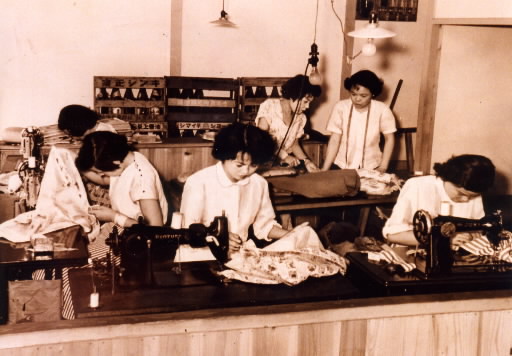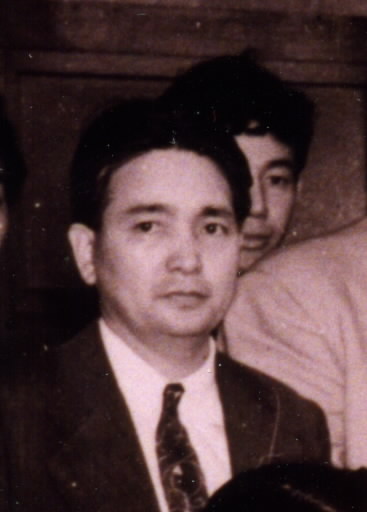Hiroshima Girls, Part 2: Bridging Japan and the United States [2]
Jul. 3, 2010
Pastor paves way for treatment in the United States
by Masami Nishimoto, Staff Writer
This feature series on the "Hiroshima Girls," also known as "Hiroshima Maidens," is a close look at a number of Japanese women who were impacted by the atomic bombing of Hiroshima. The series was originally published in 1996.
At her house in Nishi Ward, Hiroshima, which commands a view of the Seto Inland Sea, Chisa Tanimoto, 80, described her late husband concisely: "He was the kind of person who put his inspiration into action." The project to provide medical treatment for the "Hiroshima Girls" was made possible thanks to Kiyoshi Tanimoto's natural abundance of ideas and energy as well as his ties to the United States. Rev. Tanimoto, who was the pastor of Hiroshima Nagarekawa Church, died in 1986 at the age of 77.
Rev. Tanimoto was originally from Kagawa Prefecture. Before the war, he studied at the School of Theology at Emory University in the U.S. state of Georgia. Then, while the war still raged, he moved from Okinawa to Hiroshima when he was offered the role of pastor at Nagarekawa Church in 1943. Three years after he experienced the atomic bombing of Hiroshima, he spent nearly 18 months traveling through the United States and seeking out old acquaintances from his student days at Emory University. He called for the establishment of a Hiroshima Peace Center, designed to provide support to A-bomb survivors.
In his book Hiroshima Genbaku to Amerikajin ("The Hiroshima Atomic Bomb and Americans"), rev. Tanimoto wrote about his encounters in Japan with women who would come to be known as the "Hiroshima Girls" after they journeyed to the United States for medical treatment: "Right after the church service began…I found among the worshippers a young woman whose appearance conveyed painful memories of the bomb."
He came to know a woman who had been exposed to the atomic bombing while working as a mobilized student, helping to dismantle houses to create a fire lane in the event of air raids. He then invited her friends from school to visit the church. At the time, the women were around 20 years old. Later they sought financial independence by undertaking dressmaking work using donated sewing machines.
With his experience of the United States, Rev. Tanimoto had a savvy knowledge of public relations and he intentionally made use of the mass media in his efforts. When popular writer Shizue Masugi visited Hiroshima for a lecture, he brought the women along to meet her and he asked her to lend support for their medical treatment. Thanks to this move, in 1952 nine of them received treatment at Tokyo University and 12 received treatment at Osaka University and other university hospitals.
The peace treaty with the United States took effect in April of 1952, bringing the occupation of Japan to an end. The women's activities were covered widely in newspaper and on radio, with headlines such as "A-bomb Girls Visit Tokyo" and "A-bomb Maidens Visit Class-A War Criminals." But at the same time, the high-profile actions of Rev. Tanimoto came under sharp criticism. Ms. Tanimoto recalled, "People went so far as to say that he was exploiting the atomic bombing."
However, the pastor's bold efforts were a call to action to doctors in Hiroshima. Tomin Harada, 84, is a physician who accompanied the female survivors on their trip to the United States for treatment. He recalled at his home in central Hiroshima, "Why do they have to go to Tokyo? Here we are. This was the reaction of doctors in Hiroshima, who had been seeking a way to fight A-bomb diseases. We found our nerve and felt a burning ambition."
Dr. Harada began providing survivors with free medical checkups in cooperation with Dr. Goryo Ouchi, who also accompanied the girls to the United States. This eventually led to the establishment of the Hiroshima Atomic Bomb Casualty Council in the following year, 1953. [Dr. Ouchi died in 1984 at the age of 74.]
Among the directors of the Hiroshima Peace Center were Pearl Buck, a novelist, and Norman Cousins, editor-in-chief of the Saturday Review of Literature, an American weekly magazine based in New York. The moral adoption campaign, an effort to send funds to support the lives of A-bomb orphans, was launched by the U.S. arm of the Hiroshima Peace Center. [Pearl Buck died in 1973 at the age of 80. Norman Cousins died in 1990 at the age of 75.]
The project to provide medical treatment in the United States to A-bomb survivors was set in motion when Mr. Cousins paid his second visit to Hiroshima. His wife, Ellen Cousins, 82, is still well and lives in California. She recalled those days as if it were yesterday.
“Norman thought that Americans did not understand the real consequences of Hiroshima. Still, providing medical treatment in the United States was bound to have political implications. If something happened to the girls, he would have to take responsibility. Even so, he believed he should do it and he put everything he had into the project."
He sought out a hospital willing to undertake the young women's treatment. In 1955, he returned to Hiroshima with two doctors from Mount Sinai Hospital in New York. This was 18 months after he first met the girls at Nagarekawa Church. But the reaction of Hiroshima residents toward the project was mixed.
(Originally published on July 9, 1996)









